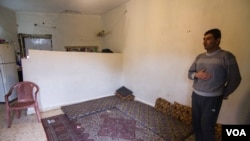Not yet teenagers, until recently Hamad and Medyan could often be found play-fighting on the couch of their family’s small flat in Lebanon’s coastal town of Batroun.
“Now things have changed,” Medyan, a Syrian refugee who works 10 hour days in a local garage, said. “We only play together on Sundays as that’s our one day off.”
Deprived of an education and with little other money coming in to the household, the 9-year-old and his brother, 10, work long hours because if they did not, there would be no one to provide for the family.
Their story is like that of many youngsters in a country where the issue of child labor has grown from a concern into a major problem.
The issue of child labor within Lebanon predates the Syrian war. But, as with other neighboring countries profoundly affected by the ongoing conflict, the situation has been exacerbated by a huge influx of refugees thought to make up a quarter of Lebanon’s population.
The International Labor Organization’s child labor consultant, Hayat Osseiran, estimates that of the refugee children of school age not being educated within Lebanon — a figure estimated by some to total between 300,000 and 400,000 — 70 to 80 percent are involved in some form of child labor.
Meanwhile, though the prevalence of child labor among Lebanese children still remains comparatively low, the pressure from the refugees — who will often work for lower salaries, whether young or old — on the local job market and on resources is raising the poverty level, forcing more Lebanese parents to send their children to work.
“It was a problem but it was nothing like it is now,” Osseiran says. She explains that while the use of children for agricultural work in poorer regions close to Syrian borders such Beq’aa and Akkar is the most common form of child labor, it can also involve anything from working in garages, nightclubs, prostitution and armed conflict.
“With the deteriorating economic situation, it’s expected that a lot of [refugee] children have to do some form of work to survive, and the situation has become worse,” she added.
“In the presence of the Syrian influx we have seen an increase in the supply of child labor and this can lead to more abuses by employers because they know that this supply has increased," she added.
And though the introduction of recent border controls with Syria is stemming the flow of refugees, finding a way to address the rapid escalation in the use of child labor is a far more complex and long-term effort.
Hamad and Medyan fled Syria three years ago in the footsteps of their father.
A taxi driver from Damascus, 30-year-old Ahmad was detained and beaten repeatedly by both government and rebel forces, both of whom he said wrongly accused him of giving transport to the other side.
He asked VOA not to reveal his family’s surname for fear of those who terrorized him back in his home country.
Since the family’s arrival in Batroun, he has worked occasional jobs but the challenges of finding work as a refugee in a saturated job market have been made worse by his disability; Ahmad lost a leg in a car accident in his home country a number of years ago.
And, he says, the cost of living in Lebanon is far higher than in Syria.
“I was able to spoil them and treated them very well in Syria, and they weren’t in need of anything, but now bad conditions have forced me to push them into work,” he said.
Hamad and Medyan speak well of their work and the way they are treated by their bosses, displaying a pride at helping the family. But for Ahmad the key to his children’s future is education.
“If they were to drive a car, they could not read the signs, if someone wrote them a letter, they’d need someone to write it for them,” he sighed.
“Education is so important and I want them to read and write.”
But education comes at a cost. Despite being labeled "free," joining many schools entails hidden fees, said Osseiran, who estimates a pricing upwards of $170 per child.
For Beirut'ss part, there have been efforts to address the problem.
Launched with the backing of Prime Minister Tammam Salam, a program working with groups like the ILO hopes to make headway on the issues by eliminating the worst forms of child labor by 2016.
But raising $23 million to fund the program is proving to be an uphill struggle, with the government stalling on providing the funds needed to encourage other donors to back the project.
Nazha Shallita, head of the child labor unit at the Ministry of Labor, said that while the current funding shortfall is a “big challenge”, alternative sources of funding are being explored.
“Now we are not depending just on the funding of the Lebanese government," she said.
“We’re working with the likes of ILO, UNICEF, civil society and others including the Danish government to launch new projects, so there is light at the end of the tunnel.”
In addressing such a complex issue, any major progress is bound to be slow.
In the meantime, those like Hamad and Medyan will continue to work, and continue to struggle for a more normal childhood.

